THE VALUE OF PLANNING
Benefits for pitch sustainability
by TurfPro Editor, Laurence Gale MSC, MBPR
I find it quite disturbing to find many grassroots sports clubs lack any form of management plan or indeed have a detailed maintenance regime in place.
This week I thought it would be timely to discuss the value of planning and the benefits it brings when managing a sports club facility in terms of sports pitch playability and sustainability.
Without a relevant planning process, clubs will often fail to deliver their goals and objectives. I find it quite disturbing to find many grass roots sports clubs (football, cricket, bowls or rugby) lack any form of management plan or indeed have a detailed maintenance regime in place.
It is quite often left to a needs must approach where treating the problem has become a chore. All too often we tend to be reactive and only do as little as possible without looking at the bigger picture.
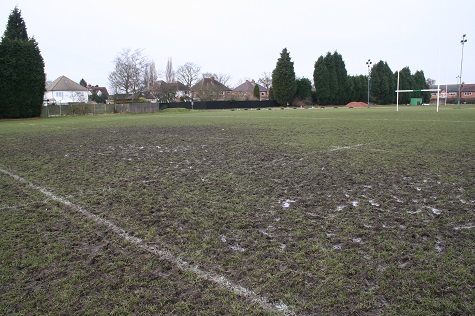
We should not view grounds maintenance in this way. We must take into account the value of the facility and what it brings to the community it serves.
Many are priceless in terms of what they bring to the community - however, in grounds maintenance terms, we often invest very little in resources and time.
One of the reasons for this, is that many clubs do not have a management / business plan that reflects the potential, values, running costs and marketing of these facilities.
What is a business plan? In its simplest form, a business plan is a guide - a roadmap for your business / club facility that outlines goals and details how you plan to achieve those goals.
Therefore, I seriously suggest you start looking at creating one. In essence it is just a working document that tells you who you are, your current state, economic value and where you want to be in the next five to ten years and how you are going to get there.
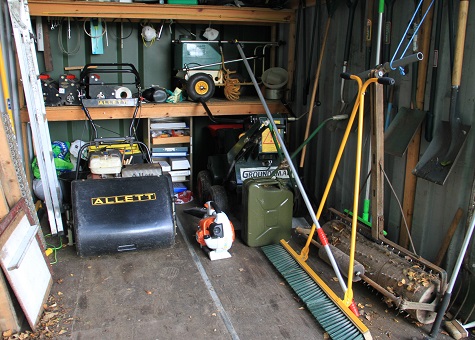
Having a viable management will also open up any potential opportunities to secure relevant funding from our sports governing bodies and other public agencies.
Ideally it should reflect the following key points about your facility:-
- A welcoming place
- Healthy, safe and secure
- Well maintained and clean
- Details maintenance plans and costs
- Meets sports governing bodies standards
- Works with the community
- Demonstrates good marketing opportunities
- And meets the needs of all club members
One of the biggest issues for me is the fact that many clubs often do not have the appropriate maintenance regimes in place or in most cases do not have the appropriate machinery and resources to do the job effectively.
We now have an excellent array of educational platforms and outlets for this information. Each sporting governing body has the relevant information for you to tap into. They nearly all provide helplines and assistance plus provide a wealth of information on running your club.
Most, if not all, of our sporting governing bodies, Sports England and the Heritage Lottery Fund, now offer funding for sports clubs. It a case of finding out what is available and how to apply for it.
As for machinery, we have in this country some of the best manufacturers in world, who over the years have brought out a raft of products to suit our needs and requirements. Followed up by an excellent network of independent, specialist machinery dealers who can supply our demands at competitive prices backed up with very good after sales services.
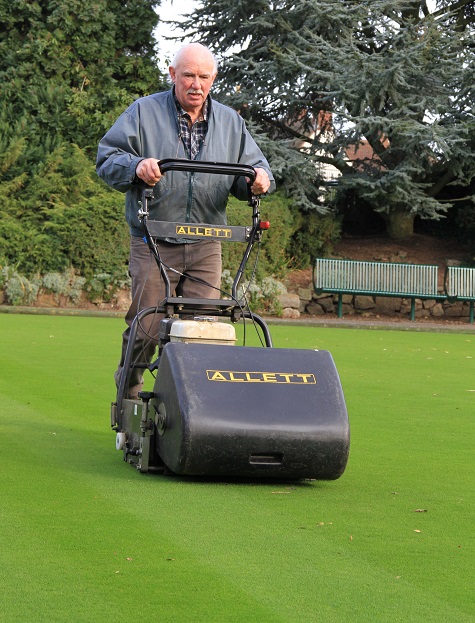
We also have other organisations such as the IOG, FA, RFU, Bowls England, ECB, LTA, STRI, SAPCA, and Pitchcare that provide essential grounds related information and maintenance diaries.
At the end of the day there will be a cost to maintain a given sports facility in terms of maintenance requirements. These will be reflected by what methods you decide. Either by doing the work in-house, employing a dedicated groundsman or hiring a qualified contractor.
Costs will be incurred whichever option you choose; however, these costs will be determined by the level of maintenance input you require and the size and scale of the club facility.
The benefit of putting together a maintenance programme is to establish these annual fees and then to find a budget scheme to fund these operations.
For many years I have advocated that a dedicated grounds maintenance budget should be set up to meet these costs. Far too often I hear clubs say ‘we haven’t the funds to do this or that’. In reality, it’s a case of being proactive and finding a way to meet these costs.
In most cases many clubs do not charge members anywhere near enough the going rates. For example, a lot of clubs still only charge between £50-£100 for annual membership and a fixed match fee (£5-£10) and expect that to cover all the costs the club incurs?!
And quite often only a small proportion of these funds ever go to maintaining the grounds.
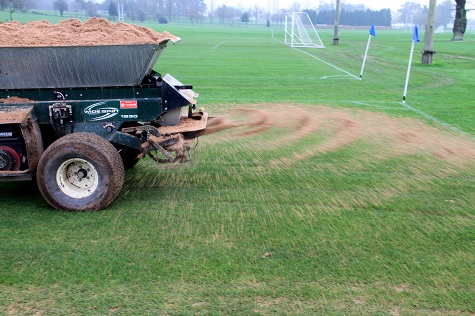
We need to find alternative methods. One I have suggested is a dedicated grounds fund whereby any club members (seniors and juniors) of a decent sized member club, who use the pitches, have to pay £1 into the groundsman’s pot. 250 plus members using the facility would equate to raising over £250 per week, £1000 per month, therefor having the potential to raise over £10,000 per year for the grounds budget. That amount of money spent effectively would go a long way to producing a decent playing surface for the club.
While on the subject of planning, January is a good time to start planning your spring renovations for cricket, tennis, bowls and possibly start thinking about your end of season renovations for rugby and football. Now is a good time to be evaluating the level of work required and acquiring costs for completing the work. It is no good expecting a contractor to turn up on a day’s notice, you will need to book them in advance.
Depending on the weather front, soil and air temperatures will soon start rising once we get into the months of March / April (only 6 weeks away).
Spring Renovations
The object of spring renovations is to give the sward a beneficial start by carrying out a light scarification, thus cleaning out any surface moss and fibre. Followed by some beneficial aeration, top dressing, overseeding work and a dose of spring NPK based fertiliser.
As for end of season renovations, quite often it requires the service of specialist contractors who are geared up with dedicated tractor mounted, scarifiers, verti-drains, top dressers and seeding machines.

And finally, just a brief reminder that I will be attending BTME next week. Myself and Steve Gibbs of TurfPro and Service Dealer will be walking around the show to see the latest innovations, machinery, products and service on offer for our everchanging and challenging sports turf industry.
 |
|
 |  |
INQUIRY INTO JAPANESE KNOTWEED IMPACT
On the built environment
The Amenity Forum has contributed to The Science and Technology Committee's inquiry into the science behind the effects of Japanese Knotweed on the built environment.
The Science and Technology Committee are holding an oral evidence session in early 2019, specifically to explore the science behind the effects of Japanese Knotweed on the built environment.
To inform that session, written submissions were invited and the Amenity Forum has made a response.

The Amenity Forum say they welcomed the inquiry. Whilst there has been research and studies on the topic, they said, it is felt more is needed if we are to fully understand the impact and implications. There has been a number of studies observing specific sites where structural damage has been caused but it is felt that more scientific studies are very much required.
The Forum also feels that more economic analysis is needed and indeed is vital to establish the financial implications now and in the future. This would assist Government greatly in establishing both its strategy and future plans to combat the issue. It is undoubtedly the case that the presence of Japanese knotweed rhizome within a construction, if left unchecked, can produce significant damage especially within masonry and hard surfaces.
The Forum also states that what has already emerged, in looking at the range of controls, is the importance of chemical products including those with the active ingredient, glyphosate. Whatever approach has been trialled, chemical treatment remains extremely important and provides the most effective approach in any integrated plan for knotweed management. They go on to say knotweed management is a long term plan and cannot be seen as a quick fix.
In a statement the Forum said, "Clearly it can be controlled by treatments but the point at which such a treatment plan is complete remains uncertain. There would appear to be a need for more research and examination of the rhizome that remains following professional treatment. Establishing the facts relating to the viability of that material when disturbed is key to establishing protocols for sites that have been subjected to a treatment programme."
Professor John Moverley, Chairman of the Amenity Forum, very much welcomed the focus on this topic and emphasised the need to use professionally trained operatives in managing the problem. He said, "What is vital is that knotweed control needs to be undertaken properly and by professionally qualified operators and organisations who fully subscribe to the standards and best practice laid down. The Amenity Forum is currently developing an overarching assurance standard for the sector and we would urge all employing any operators to ensure that they can deliver to such a standard and, in so doing, fully support the work and objectives of the Amenity Forum. Bad practice and unqualified operators can make the situation far worse and sadly there is evidence of such practices existing. The need for assured practice and the need for users such as local authorities to adopt these is vital."
The Amenity Forum is holding a series of half day Updating Events across the UK over the coming months. These are free to attend and will update those attending on current issues and concerns. There will be time for questions and essential networking.
For more information on the location and timings of these events, contact admin@amenityforum.net. Whilst free to attend, it is important that you register in advance.
 |  |
NEW GROUNDCARE SEMINAR
Launched by Dennis & Sisis
New free-to-attend groundcare seminar has been designed with education in mind for those involved in groundcare on a variety of sports turf topics.
Dennis & SISIS have announced a new free-to-attend Groundcare Seminar which has been designed with education in mind for those involved in groundcare on a variety of sports turf topics.
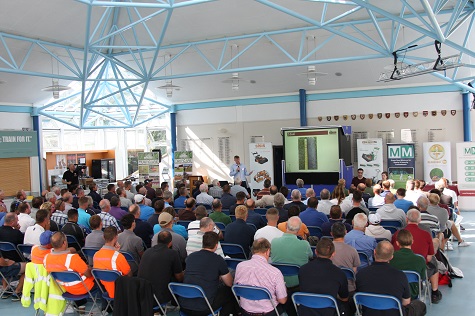
The seminar, which will take place at St. Albans School, Woollam Trust Playing Fields on Tuesday 19 February, is expected to attract grounds staff from all over the UK including volunteers and professionals representing schools, sports clubs, local authorities and contractors.
With a variety of speakers and topics, the seminar aims to connect like-minded people where they can learn new skills and techniques as well as offer networking opportunities.
Registration will start at 9am in which delegates will get the chance to meet their fellow colleagues before Robert Jack from Dennis and SISIS provides an introduction at 9.45am.
The following seminars will then take place:
- Renovate & Rejuvenate a surface - Rob Kendle (ATB Sports Solutions)
- Getting the most out of a sportsground construction project - Dr Iain James (TGMS Ltd)
- Drainage - Managing sports fields - Alex Vickers (IOG Consultant)
A complimentary lunch will signal the halfway point at 12:30pm and attendees will be able to network and meet with event sponsors.
After lunch the following seminars will commence:
- Winter sports pitches to cricket outfields - what do we do next? - Keith Kent (RFU Head Groundsman – Twickenham)
- 50 years in cricket - Looking to the future - Chris Wood (ECB Pitch Advisor)
Following presentations, informal discussions will commence where all delegates will get the opportunity to ask any questions they may have to a host of industry professionals including the seminar’s guest speakers.
To register your interest contact Roger Moore at Dennis & SISIS on 01332 824777 or email Roger on roger.moore@dennisuk.com.
 |  |
INVASIVES SCIENCE LIVE SUCCESS
Focused on Japanese Knotweed & Himalayan Balsam
Recent event showcased the latest research and technological innovations in invasive weed control.
Over 60 contractors and invasive weed eradication specialists recently attended Invasives Science Live – a unique event that showcased the latest research and technological innovations in invasive weed control.
The event, held in Cardiff, was hosted by ICL, Complete Weed Control and Green-tech in association with Advanced Invasives and provided education for delegates to gain a better understanding of chemical performance and various control methods, focussing primarily on Japanese Knotweed and Himalayan Balsam.
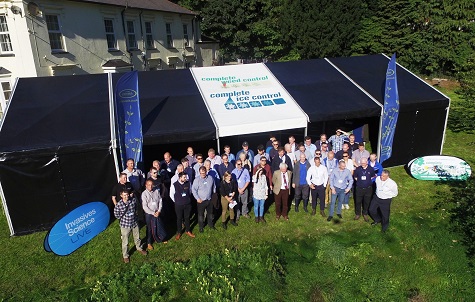
Complete Weed Control managing director Ian Graham introduced the event by offering an insight into the recent trial work with Advanced Invasives - something which the delegates would later explore in more detail at the private trial facility.
Roundup technical development manager Barrie Hunt from Bayer was the first speaker to provide an update on legal and best practice information of glyphosate to help plan ahead of their 2019 weed control programmes.
Next was Dr Dan Jones, managing director of Advanced Invasives, to give an insight into their seven year-long field trial on Japanese Knotweed control - the largest in the world. The ai:LAB is the company’s 12 acre field-testing site in South Wales where research has been undertaken into how to best tackle invasive plants in real-world conditions. The research tested 19 methods over 3 years of treatment and sets a new standard for evidence-led research.
Following Dr Dan Jones was Business Director Dan Clugston to explain the dangers of Japanese Knotweed, how it is best dealt with, and the impact it can have on property.
After lunch, delegates were transported to the nearby trial site where they were separated into three smaller groups in which they visited three specific work stations.
Station One
Beyond Balsam Bashing
Physical and herbicide control of Himalayan Balsam
Iván Martin from Advanced Invasives explained how a number of land managers are reluctant to use herbicides to control this plant, and that 'Balsam Bashing' - physical control, is a popular treatment for many conservationist groups. He went onto reveal research which consisted of benchmarking the four most commonly used balsam treatments in 5×5 m (25 m2) commercial field trial plots.
Of the treatments tested, herbicide spraying was not only fastest but also was the only treatment that does not create plant waste - and Iván claimed it is an advantage that needs to be considered when weighing the environmental benefits of treatment options.
Station Two
Life After Knotweed
Using plant functional traits to enhance recovery of invader-dominated habitats
Sophie Hocking from Swansea University and Complete Weed Control’s Ian Graham were on hand to explain how re-invasion by knotweed and secondary invasion by other plant species can often hinder future development. Sophie and Ian stated the necessity of a shift from a single, target species approach to a whole ecosystem view of recovery. This station highlighted the ongoing research which investigates the role of the functional traits of plants in habitat restoration, and the broader, long-term dynamics of Japanese knotweed invasion in field conditions.
Sophie and Ian concluded by claiming that the work will create a better, more scientifically informed framework for habitat restoration and give a clearer picture of Japanese knotweed dynamics and the habitat legacy effects of invasive species dominance.
Station Three
From Crown to Underground
Bayer Stump Treatment Trial
ICL’s Henry Bechelet and Dr Gareth Bruce from Advanced Invasives firstly discussed how stump treatment can be extremely effective as the distance the herbicide has to travel to reach the underground rhizome - the target of all herbicide treatments - is dramatically shortened.
They went on to reveal research in which three stump treatments were tested against Japanese knotweed, in triplicate 5 x 5 metre (25 m2) plots, with a control plot and also a single out-group comparison to stem injection treatment. All of the stump treatments tested were statistically comparable in effectiveness to stem injection. Results concluded that Ecoplug Max® treatment is by far the safest of the stump treatment application methods.
Commenting at the event, Ian Graham said, “We feel that this is one of the first steps in what will be a very long process in establishing facts relating to invasive weeds and we look forward to inviting guests back to the site and ensuring the work started continues.”
Professor John Moverley OBE, Chairman of the Amenity Forum commented, “Today has been very interesting. The control of Japanese Knotweed is a major issue. It’s been a great opportunity to see first-hand different approaches and some of the complexities that are involved in this level of control.”
Tony Saunders, Area Manager for JSD Rail, said: “I found the day very insightful. It introduced some new ideas that we don’t necessarily come across on the railway as we are not looking at remediating the land; we are looking at removing Japanese Knotweed. There are a number of processes that are being trialled here which added to the knowledge we have learned we are able to take back with us.”
 |  |
JENKINS JOINS WITH ISEKI
Latest dealership signed up
Jenkins Garden Machinery, based near Llanelli have become the latest garden machinery dealer to take on the ISEKI franchise.
Jenkins Garden Machinery, based near Llanelli, have become the latest garden machinery dealer to take on the ISEKI franchise - joining the growing number of ISEKI dealers across the UK.
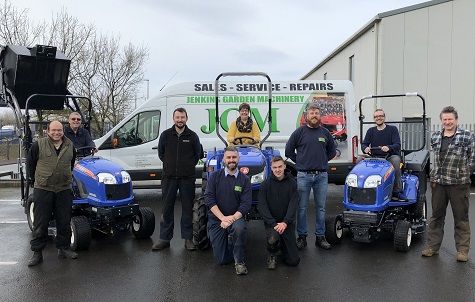
Jenkins GM team L-R: Mark Austin-Ellis, workshop technician; Howell Jenkins, dealer principal & sales director; Kevin Ward, after sales manager; Emyr Jenkins, managing director; Glynis Jenkins, financial director; Kane Necke, workshop apprentice; Matthew Begley, stores manager & sales; Gareth Jenkins, after sales director; Philip Gardiner, workshop technician
Dealer principal, Howell Jenkins, commented, "Our business has changed dramatically in the last few years with customers seeking more commercial machinery. This partnership with ISEKI will help us serve those customers better."
Emyr Jenkins, managing director added, “ISEKI have a long-standing reputation for quality of product and service in the UK which is exactly what we strive to deliver to our customers on a daily basis. Additionally the amazing performance of the cut and collect machines is really a big deal for us in South Wales where the grass grows so strongly.”
David Withers, managing director of ISEKI UK says he was pleased to add Jenkins Garden Machinery to the ISEKI family and commented, “We enjoy working with companies that have the same focus we have on customer service and long-term relationships. As such we are excited to add Emz (as Emyr is usually know) and the team to the ISEKI family.”
 |  |
VICTORY FOR JOHN O’CONNER GROUNDS MAINTENANCE
At BALI National Landscape Awards
Award sponsors Toro and Reesink Turfcare announced contractor were the winners for their work at Emergency Planning College (EPC), The Hawkhills.
Award sponsors Toro and Reesink Turfcare, an official UK Toro distributor, have announced that John O’Conner Grounds Maintenance are the principle award winners for their sponsored Grounds Maintenance - Limited Public Access category, at the British Association of Landscape Industries (BALI) National Landscape Awards.
John O’Conner were announced as the winners at a ceremony held at London’s Grosvenor House on 7 December, for its work at Emergency Planning College (EPC), The Hawkhills, a leading provider of high-quality training for public, private and voluntary organisations.

Left to right: Alastair Rowell, Reesink Turfcare, Ronnie Christie and Kasia Kepa from Serco with Neil Cain, Matt O’Conner, Martine Dorrington, Ian Pitkin, Simon Pannel, Heather Eaton and John O’Conner from John O’Conner Grounds Maintenance
John O’Conner received the award with its client Serco after an adjudicator visited the college and reviewed the grounds to see first-hand the excellent management employed and the work of the on-site staff at the 240-acre estate, which includes landscaped gardens, woods and natural parklands.
Managing director at John O’Conner, Matt O’Conner, who coincidentally happens to be the BALI chairman, said, “We’re delighted that EPC has been awarded the principle award in its category at the BALI National Landscape Awards. This is the result of a strong partnership with our client and shows what can be achieved when you work hand-in-hand to improve standards.
“Credit must of course go to our on-site staff who have worked so hard to deliver exemplary standards on this prestigious site. It is a great example of the high level of service that we deliver for our customers day in and day out.”
With tough competition for the award, the project impressed the judges with the level of skill and professionalism displayed. One of the judges declared, “The contractor has done a great deal to improve standards in the grounds of this important venue. Client satisfaction is high, and they are aware that as standards increase, staffing and budgets must follow to maintain the overall look of the site. Regardless, this is a very impressive scheme and a credit to the efforts of the contractor’s on-site staff.”
The award was presented to John O’Conner by Reesink Turfcare’s Alastair Rowell, in front of an audience of over 1000 BALI members and guests at the 42nd annual awards. The runner-up and fellow national award winner in the category, announced in September, was Gavin Jones for Brompton Barracks - Royal School of Military Engineers.
Alastair Rowell, Reesink accounts manager for grounds concludes: “We are very proud to sponsor this award with Toro and have the opportunity to commend the most exciting and progressive landscaping projects. As Toro is renowned for its innovation in groundscare equipment, we have a keen interest in helping to shape the future of the turfcare and landscaping industry. We are thrilled to have seen John O’Conner win this award and congratulate all those involved with this year’s winning project.”
 |  |
CAMPEYS TO ATTEND GIS '19
With Dakota and Air2G2
The Golf Industry Show (GIS) 2019 in San Diego is one of golf’s premier learning and networking events.
Campey Turf Care Systems will be attending the Golf Industry Show (GIS) 2019 in San Diego with Dakota and Air 2G2 GT Air Inject.

The GIS is one of golf’s premier learning and networking events and representatives from Campey, Richard Campey, Ben Taylor and Dave Harrison, will be joining colleagues from Air 2G2 and Dakota to provide expert insight into the machines and their use on Europe’s most prestigious golf courses.
Campey sells the Air2G2 Air Inject GT around the globe and since introducing it into the United Kingdom and Europe, it has become increasingly popular and is now in operation at many leading golf venues.
The three Campey representatives will also be at the Dakota booth, promoting the company's range of Turf Tenders, with Dakota routinely fine-tuning their spreaders to make them even more accurate.
The company say they have also listened to the needs of the golf industry and introduced the pedestrian 310 SP model alongside the 410 towed model.
LYNX FOR LINKS
At Newquay Golf CLub
Head greenkeeper Dan Kendle praises new Toro Lynx control system and Flex Series sprinklers and says its "the talk of the county".
Newquay Golf Club in Cornwall, a traditional links course with traditional links irrigation issues, has chosen Toro Lynx control system and Flex Series sprinklers to keep the course in top condition.
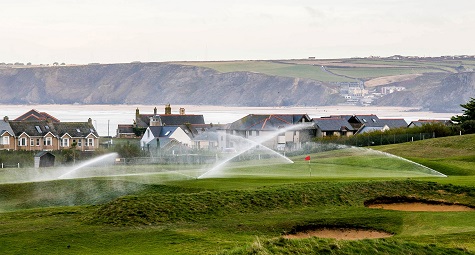
Head greenkeeper Dan Kendle explained, “It was time for a new system, but we also wanted to make sure we have a system which could cope with the fact that we’re an exposed links course. We’re built on sand dunes beside the Atlantic Ocean and we get a lot of wind and salt spray. I knew we needed an irrigation system capable of dealing with that.”
Dan worked with irrigation specialists Irritech to assess the current system and design a new one. The process concluded with Full Circle Irrigation installing a Toro Lynx Central Control System with FLEX 35 and 55 Series sprinklers provided by Reesink Turfcare on the greens, surrounds and approaches last winter.
“Our old system wasn’t efficient in terms of the time it was taking and the water it was using,” comments Dan. “It was malfunctioning to the point where we couldn’t use it automatically overnight and had to water manually by hand in the day, which wasted valuable resources and time that could be otherwise spent maintaining the course. The difference since we switched to Toro is massive. We now have denser and greater grass coverage, especially across the greens.
"Members say they can’t believe how much better the course is now, and the buzzword is our greens are the talk of the county!”
Newquay Golf Club has long been a Toro machinery customer, but say Toro Irrigation was chosen on merit through extensive research and viewing different systems in action.
“We already had a full fleet of Toro machines, so from the start I was keen to go with Toro as it’s proved itself to be reliable and dependable. However, it was important we considered all the options before deciding and we were really thorough with the process. It’s a big investment and members needed assurance we’d done our research. We had a lot of discussions and went to see the Lynx system and another brand in action. After seeing how they operated, it was clear that the superior system was Toro’s.”
 |
|
 |  |
ADVERTISE YOUR JOBS HERE
Amazing success rates!
Advertise your recruitment needs on TurfPro Weekly Briefing and reach our targeted audience of recipients every week.
Contact Nikki Harrison for details - 01491 837117
|
 |  |
 |  |
 |  |
 |  |
 |  |
THE TRUE COST OF PETROL
Battery-powered outdoor power tools are now turning the heads of professionals
by Vince Brauns, European Product Manager at EGO UK
In the world of professional landscaping and grounds maintenance, petrol has been the fuel of choice for over 100 years. Recently however, battery-powered cordless equipment has gained worldwide popularity and increased market share.
Battery-powered outdoor power tools are surging in popularity. For a while, they have been a convenient choice for domestic gardeners however the health, noise and cost benefits of using battery over their fossil-fuelled counterparts are now turning the heads of professionals, says Vince Brauns, European Product Manager at EGO UK.
In the world of professional landscaping and grounds maintenance, petrol has been the fuel of choice for over 100 years – mainly because there has been no viable challenger. Recently however, battery-powered cordless equipment has gained worldwide popularity and increased market share, signaling the most significant shift in the sector for decades.
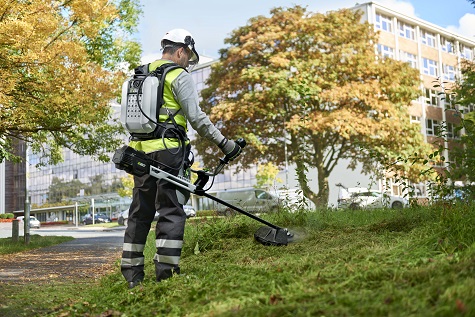
Ears to the Ground
A reduction in noise pollution is just one of the benefits driving the industry’s journey to an all-electric future. The World Health Organization (WHO) considers noise to be second only to air quality as the largest environmental cause of health problems.
Equally, on a website dedicated to noise pollution, the European Commission writes: ‘Prolonged exposure to noise can lead to serious health effects mediated by the human endocrine system and by the brain, such as… cardiovascular diseases, annoyance, cognitive impairment and mental health problems… (which can lead) to a loss of productivity of workers.’
Unsurprisingly therefore, European noise legislation is becoming ever more stringent with both the European Commission’s Machinery Directive 2006/42/EC and the Outdoor Noise Directive 2000/14/EC (OND) looking to regulate noise emissions caused by some 57 types of outdoor equipment – including those used in parks and gardens.
Furthermore, the new Physical Agents (Noise) Directive 2003/10/EC currently sets a maximum exposure limit of 87dB in working environments. Petrol powered equipment exceeds this at operator level (1 metre away). A petrol-powered chainsaw, for example, emits 105 dBA at operator level, while a petrol lawnmower at the same distance emits 96 dBA.
By comparison, a battery-powered mower from EGO emits 87dBA at operator level, while its chainsaw actually falls in at just 85 dBA.
The deafening reality
As a professional, its useful to know the details of EU directives and how your equipment stacks up in comparison. In reality, health effects are more likely to drive one’s decision to ditch the petrol.
It’s no secret that workers exposed to loud noise over a long period of time are more likely to lose their hearing – a phenomenon called noise-induced hearing loss (NIHL). NIHL, caused by damage to sensitive structures in the inner ear, is estimated to affect over 18,000 people in the UK. These sensitive structures, known as hair cells, are tiny sensory cells that convert sound energy into electrical signals that travel to the brain. Once damaged, these hair cells do not grow back. This is why it is wise to understand the level of noise exposure you are subjected to and consider this when replacing tools and equipment.
Fuel for thought
Much like the argument against fossil-fuelled vehicles, emissions from petrol-powered machinery and equipment can cause very real health problems.
In 2017, the Deutsche Umwelthilfe e.V. (Environmental Action Germany) undertook extensive testing of 21 hand held engines, including motor saws and brush cutters, from European suppliers. Their research revealed that nine failed to comply with EU limit values for hydrocarbons and carbon monoxide, while three exceeded the limit value.
This is worrying, as the harmful impact of petrol emissions – especially benzene – are widely documented and understood. According to WHO, regular exposure can lead to a range of acute and long-term adverse health effects and diseases, including cancer and aplastic anaemia.
As a result, the European Commission is making a concerted effort to minimise the damage caused by what it calls NRMMs – ‘non-road mobile machinery’ – including mowers, leaf blowers and chainsaws among others. With zero chemical emissions during use, battery powered cordless equipment is unaffected by these directives – and will remain unaffected well into the future.
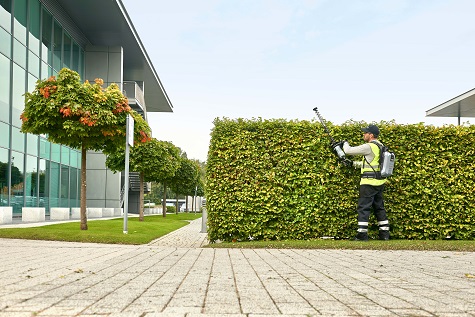
Killing time
In addition to adverse health effects, noise created by tools can aggravate residents and the occupants of nearby buildings. When operating in residential and commercial areas, those using petrol-powered tools will be all too familiar with the internal dilemma of what time is too early to start up the 2-stroke engine. Similarly, those working on the grounds of schools and hospitals will have wondered how much disruption their mower, blower or hedge trimmer is causing to the buildings occupants.
Most councils have by-laws that guide construction workers about the standard hours where noisy work is usually acceptable, which is often adhered to by professional landscapers and gardeners too. This usually sits somewhere between 8am and 6pm on weekdays, 8am and 1pm on Saturdays and no work on Sundays.
Like petrol, battery powered cordless equipment is also subject to noise restrictions but is better able to meet the stringent requirements. The net result is that workers can enjoy improved comfort, communication and teamwork, while their business benefits from less disruption and a continuous working schedule.
Up in smoke
For businesses, being able to complete work more quietly allows more jobs to be done in a single day and in turn, increases the productivity of workers. In some cases, this means that the switch to electric may even enable businesses to onboard additional clients and increase their revenues.
It is however, no myth that battery powered equipment is more expensive than petrol in the first instance. Included in the price of your tool is the battery but once it is purchased, it will act as your fuel source for the next four to five years.
As part of its 2014 Procurement Directive, the European Commission encourages public authorities to consider this whole life-cycle cost, rather than just the initial cost of purchase. Although this philosophy of ‘Green Procurement’ has taken root in the public sector, it is increasingly being adopted by private companies looking to maximise their environmental and economic advantage.
Recent research from EGO investigated the total cost of ownership between petrol and battery powered outdoor equipment.
The test looked at the cost of a petrol brush cutter, hedge trimmer and leaf blower compared with their battery-powered counterparts. Initially, buyers would spend approximately £690 extra on battery-powered equipment in year one however would break even in their second year, making a total saving of £365. In years three and four, the real savings of ditching the petrol begin to show themselves with users saving a total of £1,430 and £3,500 respectively.
By the fifth and final year, the test factored in a full replacement of all equipment and yet the savings amounted to a total lifetime saving of over £4,500! In the study, seasonal use of certain tools was considered and as result, fuel equivalents were based upon daily usage of four litres per day over a modest 170 days per year. With more frequent use, payback time would be accelerated even further.
It’s important to note that the payback time of investment will be directly affected by the amount of ‘idle’ time, usage patterns, and even ambient temperatures which affect the energy capacity of the battery. Matching the right batteries to applications is therefore a critical thing to consider.

A brighter future
With rising energy costs and concerns over health, safety and the environment, the use of petrol powered outdoor equipment is coming under increasing scrutiny and is now subject to ever more stringent legislation. Against this, battery powered cordless technology has improved significantly and now offers similar – if not better – performance than petrol alternatives.
The industry now recognises cordless as a truly viable alternative to petrol. With increasing battery power, minimal pollution and increased efficiency gains to be gained, battery-powered landscaping and gardening equipment is going from strength to strength.
To read more about battery v petrol, download the latest whitepaper from EGO here.
 |
|
|
|